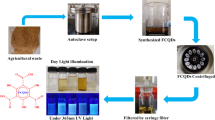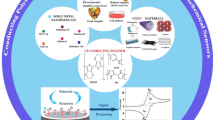Abstract
A simple and effective graphene oxide-magnetic relaxation switch (GO-MRS) sensor that combines graphene oxide (GO) and aptamer-modified poly-L-lysine(PLL)-Fe3O4 nanoparticles (Fe3O4@PLL–Apt NPs) was designed for the detection of acetamiprid (ACE). In this sensor, Fe3O4@PLL–Apt NPs acted as a relaxation signal probe and GO facilitated the generation of relaxation signal changes (dispersion/aggregation shift), while the aptamer is a molecular component that recognizes ACE. This GO-assisted magnetic signal probe improves the stability of magnetic nanoparticles in solution and enhances their sensitivity to small molecules while avoiding cross-reactions. Under optimal conditions, the sensor exhibits a wide working range (10–80 nM) and low detection limit (8.43 nM). The spiked recoveries ranged from 96.54 to 103.17%, with a relative standard deviation (RSD) of less than 2.3%. In addition, the performance of the GO-MRS sensor matched that of the standard method (liquid chromatography-mass spectrometry (LC–MS)), indicating that the GO-MRS sensor is suitable for the detection of ACE in vegetables.
Graphical Abstract






Similar content being viewed by others
Data availability
The data that support the findings of this study are available from the corresponding author, [Xin Wang], upon reasonable request.
References
Seccia S, Fidente P, Barbini DA, Morrica P (2005) Multiresidue determination of nicotinoid insecticide residues in drinking water by liquid chromatography with electrospray ionization mass spectrometry. Anal Chim Acta 553(1):21–26. https://doi.org/10.1016/j.aca.2005.08.006
Ragas AMJ, Oldenkamp R, Preeker NL, Wernicke J, Schlink U (2011) Cumulative risk assessment of chemical exposures in urban environments. Environ Int 37(5):872–881
Jin D, Xu Q, Yu L, Mao A, Hu X (2016) A novel sensor for the detection of acetamiprid in vegetables based on its photocatalytic degradation compound. Food Chem 194:959–965. https://doi.org/10.1016/j.envint.2011.02.015
Kuang L, Wang Z, Cheng Y, Li Y, Li H, Zhang J, Shen Y, Li J, Xu G (2023) Residue levels and risk assessment of pesticides in litchi and longan of China. J Food Compos Anal 115:104921. https://doi.org/10.1016/j.jfca.2022.104921
Tsourkas A, Hofstetter O, Hofstetter H, Weissleder R, Josephson L (2004) Magnetic relaxation switch immunosensors detect enantiomeric impurities. Angew Chem Int Ed 43(18):2395–2399. https://doi.org/10.1002/anie.200352998
Cai S, Liang G, Zhang P, Chen H, Zhang S, Liu B, Kong J (2011) A miniature chip for protein detection based on magnetic relaxation switches. Biosens Bioelectron 26(5):2258–2263
Silva RN, Vijayan AN, Westbrook E, Yu Z, Zhang P (2019) Nanoparticle assisted nuclear relaxation-based oligonucleotide detection. Anal Chim Acta 1062:118–123. https://doi.org/10.1016/j.bios.2010.09.045
Zheng W, Zeng L, Chen Y (2020) Bioorthogonal reactions amplify magnetic nanoparticles binding and assembly for ultrasensitive magnetic resonance sensing. Anal Chem 92(3):2787–2793. https://doi.org/10.1021/acs.analchem.9b05097
Dong Y, Zheng W, Chen D, Li X, Wang J, Wang Z, Chen Y (2019) Click reaction-mediated T2 immunosensor for ultrasensitive detection of pesticide residues via brush-like nanostructure-triggered coordination chemistry. J Agric Food Chem 67(35):9942–9949. https://doi.org/10.1021/acs.jafc.9b03463
Dong Y, Chen R, Wu L, Wang X, Jiang F, Fan Z, Huang C, Chen Y (2022) Magnetic relaxation switching biosensor via polydopamine nanoparticle mediated click chemistry for detection of chlorpyrifos. Biosens Bioelectron 207:114127. https://doi.org/10.1016/j.bios.2022.114127
Wu L, Zhou M, Liu C, Chen X, Chen Y (2021) Double-enzymes-mediated Fe2+/Fe3+ conversion as magnetic relaxation switch for pesticide residues sensing. J Hazard Mater 403:123619. https://doi.org/10.1016/j.jhazmat.2020.123619
Xianyu Y, Wang Q, Chen Y (2018) Magnetic particles-enabled biosensors for point-of-care testing. TrAC Trends Anal Chem 106:213–224. https://doi.org/10.1016/j.trac.2018.07.010
Dong M, Zheng W, Chen Y, Ran B, Qian Z, Jiang X (2018) Cu-T1 sensor for versatile analysis. Anal Chem 90(4):2833–2838. https://doi.org/10.1021/acs.analchem.7b04971
Bamrungsap S, Shukoor MI, Chen T, Sefah K, Tan W (2011) Detection of lysozyme magnetic relaxation switches based on aptamer-functionalized superparamagnetic nanoparticles. Anal Chem 83(20):7795–7799. https://doi.org/10.1021/ac201442a
Piacenza E, Presentato A, Turner RJ (2018) Stability of biogenic metal(loid) nanomaterials related to the colloidal stabilization theory of chemical nanostructures. Crit Rev Biotechnol 38(8):1137–1156. https://doi.org/10.1080/07388551.2018.1440525
Abedin MR, Umapathi S, Mahendrakar H, Laemthong T, Coleman H, Muchangi D, Santra S, Nath M, Barua S (2018) Polymer coated gold-ferric oxide superparamagnetic nanoparticles for theranostic applications. J Nanobiotechnology 16(1):80. https://doi.org/10.1186/s12951-018-0405-7
Wang JY, Guo QY, Yao ZY, Yin N, Ren SY, Li Y, Li S, Peng Y, Bai JL, Ning BA, Liang J, Gao ZX (2020) A low-field nuclear magnetic resonance DNA-hydrogel nanoprobe for bisphenol A determination in drinking water. Mikrochim Acta 187(6):333. https://doi.org/10.1007/s00604-020-04307-6
Huang L, Liu S, Ren S, Zhang M, Wang T, Wang X, Gao Z (2021) Magnetic relaxation switch biosensors based on self-assembly of polystyrene microspheres and magnetic nanoparticles for detection of bisphenol A. ACS Appl Nano Mater 4(6):5963–5971. https://doi.org/10.1021/acsanm.1c00845
Liu B, Salgado S, Maheshwari V, Liu J (2016) DNA adsorbed on graphene and graphene oxide: fundamental interactions, desorption and applications. Curr Opin Colloid Interface Sci 26:41–49. https://doi.org/10.1016/j.cocis.2016.09.001
Wu M, Kempaiah R, Huang PJ, Maheshwari V, Liu J (2011) Adsorption and desorption of DNA on graphene oxide studied by fluorescently labeled oligonucleotides. Langmuir 27(6):2731–2738. https://doi.org/10.1021/la1037926
Bogdan N, Vetrone F, Ozin GA, Capobianco JA (2011) Synthesis of ligand-free colloidally stable water dispersible brightly luminescent lanthanide-doped upconverting nanoparticles. Nano Lett 11(2):835–840. https://doi.org/10.1021/nl1041929
Shao H, Yoon TJ, Liong M, Weissleder R, Lee H (2010) Magnetic nanoparticles for biomedical NMR-based diagnostics. Beilstein J Nanotechnol 1:142–154. https://doi.org/10.3762/bjnano.1.17
Liu T, Liu Y, Chen Y, Liu S, Maitz MF, Wang X, Zhang K, Wang J, Wang Y, Chen J, Huang N (2014) Immobilization of heparin/poly-(L)-lysine nanoparticles on dopamine-coated surface to create a heparin density gradient for selective direction of platelet and vascular cells behavior. Acta Biomater 10(5):1940–1954. https://doi.org/10.1016/j.actbio.2013.12.013
Mateu-Sánchez M, Moreno M, Arrebola FJ, Martínez Vidal JL (2003) Analysis of acetamiprid in vegetables using gas chromatography-tandem mass spectrometry. Anal Sci 19(5):701–704. https://doi.org/10.2116/analsci.19.701
Shi H, Zhao G, Liu M, Fan L, Cao T (2013) Aptamer-based colorimetric sensing of acetamiprid in soil samples: sensitivity, selectivity and mechanism. J Hazard Mater 260:754–761. https://doi.org/10.1016/j.jhazmat.2013.06.031
Di Muccio A, Fidente P, Barbini DA, Dommarco R, Seccia S, Morrica P (2006) Application of solid-phase extraction and liquid chromatography–mass spectrometry to the determination of neonicotinoid pesticide residues in fruit and vegetables. J Chromatogr A 1108(1):1–6. https://doi.org/10.1016/j.chroma.2005.12.111
Poshteh Shirani M, Rezaei B, Ensafi AA (2019) A novel optical sensor based on carbon dots embedded molecularly imprinted silica for selective acetamiprid detection. Spectrochim Acta, Part A 210:36–43. https://doi.org/10.1016/j.saa.2018.08.030
Lin B, Yu Y, Li R, Cao Y, Guo M (2016) Turn-on sensor for quantification and imaging of acetamiprid residues based on quantum dots functionalized with aptamer. Sens Actuators, B 229:100–109. https://doi.org/10.1016/j.snb.2016.01.114
Huang L, Wang X (2021) Rapid and sensitive detection of bisphenol A in water by LF-NMR based on magnetic relaxation switch sensor. Microchem J 163:105911. https://doi.org/10.1016/j.microc.2020.105911
Epa U (2005) Code of federal regulations (CFR). Washington, DC: US Environmental Protection Agency (Part 180, July 1, 40)
Wu Z, Huang C, Dong Y, Zhao B, Chen Y (2022) Gold core @ platinum shell nanozyme-mediated magnetic relaxation switching DNA sensor for the detection of Listeria monocytogenes in chicken samples. Food Control 137:108916. https://doi.org/10.1016/j.foodcont.2022.108916
Huang Y, Ren J, Qu X (2019) Nanozymes: classification, catalytic mechanisms, activity regulation, and applications. Chem Rev 119(6):4357–4412. https://doi.org/10.1021/acs.chemrev.8b00672
Funding
This work was supported by the National Natural Science Foundation of China (No. 81773482).
Author information
Authors and Affiliations
Contributions
Lei Huang: writing—review and editing, formal analysis, software; Kaili Pei: methodology, writing—original draf; Xin Wang: validation, project administration, supervision, funding acquisition.
Corresponding author
Ethics declarations
Conflict of interest
The authors declare no competing interests.
Additional information
Publisher's Note
Springer Nature remains neutral with regard to jurisdictional claims in published maps and institutional affiliations.
Highlights
1. A sensitive method for acetamiprid in vegetables was proposed.
2. A graphene oxide-magnetic relaxation switch (GO-MRS) sensor was designed.
3. This method has a satisfactory LOD (8.43 nM).
4. The detection of acetamiprid in real samples was agreed with LC-MS.
Supplementary Information
Below is the link to the electronic supplementary material.
604_2023_5817_MOESM1_ESM.pdf
Supplementary file1 (PDF 1637 KB) Instruments, experimental materials, detailed methods, and relevant analytical data can be found in the Electronic Supporting Material.
Rights and permissions
Springer Nature or its licensor (e.g. a society or other partner) holds exclusive rights to this article under a publishing agreement with the author(s) or other rightsholder(s); author self-archiving of the accepted manuscript version of this article is solely governed by the terms of such publishing agreement and applicable law.
About this article
Cite this article
Huang, L., Pei, K. & Wang, X. Magnetic relaxation switch sensor based on aptamer-modified poly-L-lysine-ferroferric oxide magnetic nanoparticles and graphene oxide for the determination of insecticides in vegetables. Microchim Acta 190, 239 (2023). https://doi.org/10.1007/s00604-023-05817-9
Received:
Accepted:
Published:
DOI: https://doi.org/10.1007/s00604-023-05817-9




